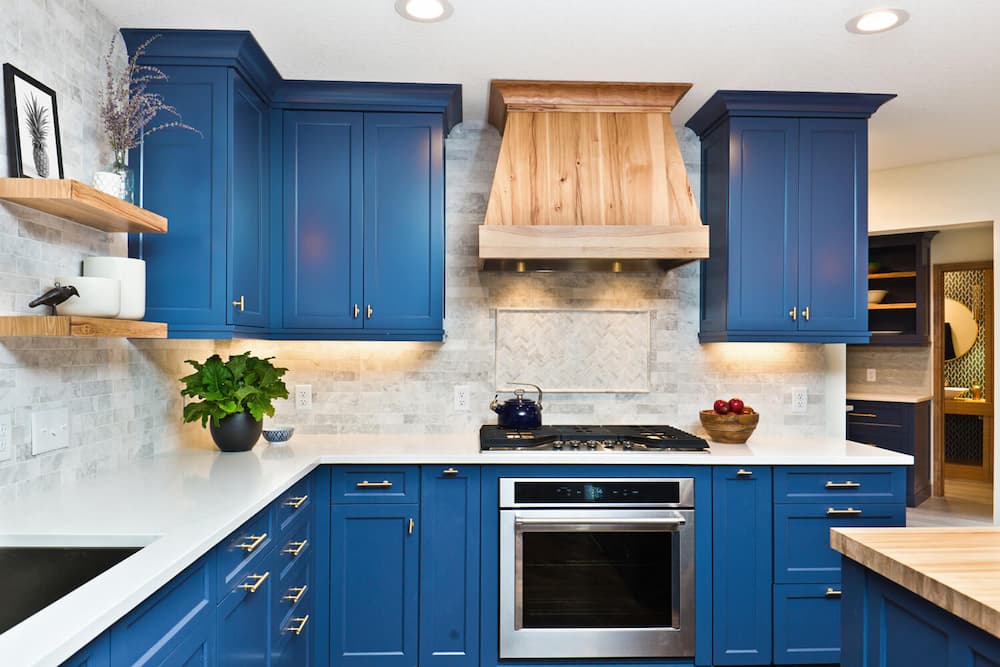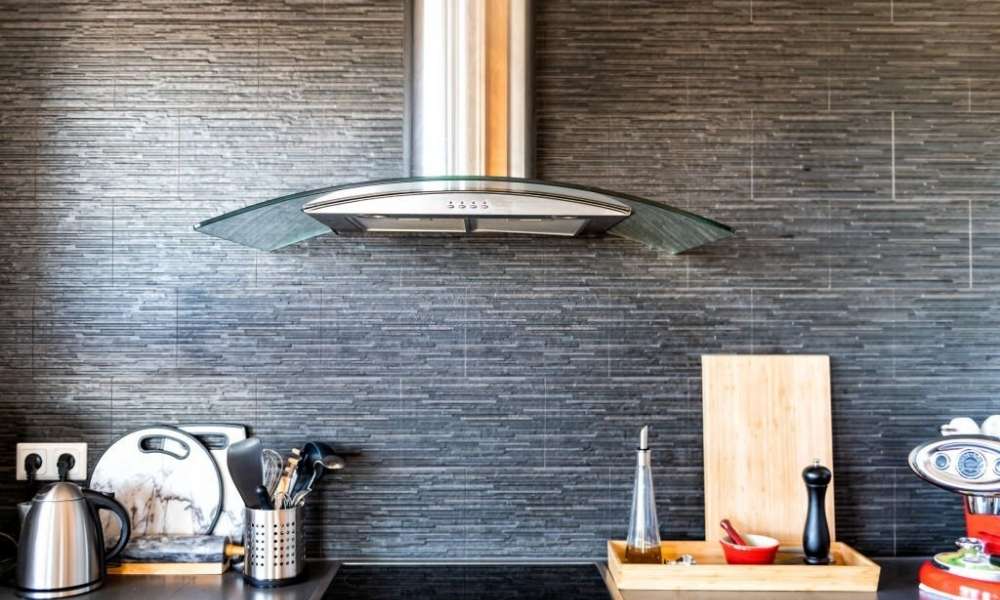The steam and heat generated while cooking must be vented outside the house using a kitchen vent pipe. Instead of moving the pipe, think about a few design solutions to bury it. The overall appearance of your kitchen might be enhanced by these decorative alternatives. There are a few methods that figuratively hide the pipe, but with a little imagination, it’s possible to hide a kitchen vent pipe by deflecting attention to something else.
How to hide kitchen vent pipe: false cabinets, paints to cover the kitchen vent pipe, issues with bulkhead, soffits or columns…
Please continue reading for more information.
Table of Contents
How To Hide Kitchen Vent Pipe?
False Cabinets
According to the Contemporist, you might be able to install a false cabinet to hide the pipe’s presence, depending on its length and wall orientation. Prefabricated, backless cabinets that match or at least closely resemble your existing cabinets are typically available from most kitchen design outlets and building centers, or you can build your own. Cut a hole in the top and bottom of the cabinet for the pipe to pass through.
Make sure that the diameter of the pipe is at least one inch larger than these openings. The height of your cabinets along the wall where the pipe is located can also be raised. You have added more storage to yourself in addition to hiding the unsightly pipe.
Paints To Cover The Kitchen Vent Pipe
The right kind of paint must be used if you want to conceal a vent pipe.
Use an oil-based primer and an eggshell finish on your base coat if it’s metal, or use latex paint with high hiding power. Just keep in mind that any moisture will lead to rusting once more, so only attempt this if there won’t be any moisture around the pipes or in the cabinet where they are located for at least 24 hours after painting them! Prior to applying two coats of primer and one topcoat that is color-matched to your wall color (or not), make sure to thoroughly clean the surface.
If you have the time, a faux finish like glaze effects is a good way to conceal the kitchen vent pipe because it looks nice without needing to be painted. If you choose to do this, start with flat latex paint and add glaze medium to simulate oil-based enamel or gel stain, depending on what suits the decor of your home best.
Issues With Bulkhead
Installing a bulkhead, or drywall box that runs around your kitchen’s perimeter above the cabinets, was a traditional technique for hiding vent pipes in kitchens. The issue with this is that it is bulky, it restricts your design options, and it gives your kitchen a dated appearance, regardless of how contemporary your other design elements are.
When deciding whether to construct a bulkhead over your pipes, take these factors into account. Also take into account the state of the pipe itself. Replace the pipe if it is old, rusted, or damaged to make it more aesthetically pleasing, especially if your kitchen has stainless steel appliances. Instead of sticking out like a sore thumb, a shiny new pipe can frequently be used to highlight these design features.
Soffits Or Columns
For concealing kitchen vent pipes, this is the best choice. Typically, soffits are dropped from the ceiling and placed in cabinets or along walls where cabinets have already been built.
Here is what you can do:
- Measure and cut appropriate sized PVC pipe to fit inside of soffit with hacksaw/saw/or another tool until it fits perfectly snug within the space provided by the new appliance – leaving just enough room between each piece for airflow purposes if that’s what you’re looking for;
- Keep this in mind when measuring out lengths as well since these pieces will need to properly slot into place once they are secured at their desired height above ground level (that means no wacky measurements like 47 feet long) unless of course, this is something you’re looking for;
- If using ABS plastic pipes, prime them first before joining pieces together with PVC cement and solvent glue (follow the instructions on the can). Check all connections to ensure there are no leaks. If so, keep applying more of either glue until dry before running water through the finished project – otherwise, you might end up having to start all over again;
Decorative Molding Or Trim
Investing in decorative molding or trim to conceal the kitchen vent pipe is a wise move. Vent pipes are frequently ugly and can ruin the appearance of your kitchen. The energy efficiency of your home may also be impacted by them as a source of drafts.
You can make your kitchen more aesthetically pleasing and energy-efficient by covering the vent pipe with molding or trim. Additionally, molding or trim can help to muffle vent pipe noise, enhancing the ambiance of your kitchen.
Cabinets
Many homeowners choose to use a cabinet to conceal the vent pipe. One advantage of using a cabinet is that you can conceal the vent pipe while still getting enough ventilation.
By capturing grease and other contaminants, using a cabinet can also help to improve the air quality in your kitchen. Cabinets can also add to your kitchen’s storage space by serving as additional shelves.
Route The Pipe Through The Ceiling Or Another Hidden Area
The next logical place for a vent pipe to run is through the ceiling because it serves as the room’s upper limit as opposed to following the floor. The aesthetics of your kitchen can also be enhanced by hiding the pipe behind a ceiling.
And if you’re concerned about possible leaks, don’t be; spills or other water damage aren’t close to the ceilings. Therefore, look no further than the ceiling if you’re looking for a way to covertly conceal your vent pipe.
Tapestry Or Curtains
Even if you don’t have any renovations planned, you can still cover the pipe by draping a curtain or tapestry in front of it. This is a simple and affordable way to hide the pipe.
You can contribute to making sure that your kitchen vent pipe is both secure and concealed by taking these steps.

The Problem With Exposed Kitchen Vent Pipes
The heat, smoke, and odors that are produced in the kitchen can be expelled using a vent pipe. However, if it is not covered, it may also be unsightly. A clogged vent may eventually result from the pipe accumulating grease and dirt.
A poorly maintained vent may also present a fire risk. Therefore, it’s crucial to make sure the kitchen vent pipe is concealed.
Which Technique Suits You The Best?
Depending on your unique situation, you can choose the best hiding place for your kitchen vent pipe.
Using a false wall might be the best choice if your kitchen is small. Use of a soffit might be preferable if your kitchen is large.
Which method will function best in your kitchen is ultimately up to you. You can make sure that your kitchen vent pipe is hidden from view and does not present a safety hazard by taking the time to carefully weigh your options.
Which Materials Work Best To Conceal The Kitchen Vent Pipe?
There are a number of materials you can use to cover exposed vent pipes if you don’t like the industrial appearance of them.
Wood is a popular material because it can be painted or stained to match your cabinets. Use stainless steel or glass for a more contemporary appearance. Both materials go well with other kitchen finishes and are simple to clean.
The vent pipe could even be covered with wallpaper or fabric if you’re looking for something a little more distinctive. The possibilities for concealing those unsightly pipes are endless! See more about How To Get Rid Of Flies In An Orangery?
The Pros And Cons Of Hiding Vent Pipe
Hiding the kitchen vent pipe is a great way to improve the look of your kitchen, and weighing the pros and cons can help you choose whether to conceal it:
Pros
- One advantage is that it will make your kitchen look better.
- Another advantage is that it can lessen the likelihood of grease and dirt amassing on the pipe.
Cons
- If the pipe is concealed, cleaning it might be more challenging.
- If the pipe is damaged, it might be more challenging to fix it.
Considerations For Venting A Kitchen
Ventilation should be taken into consideration when remodeling a kitchen. The air is kept fresh and circulated while being removed by proper ventilation, which also helps to remove fumes and smoke. Ventilation can be achieved in a kitchen in a few different ways.
Installing a range hood that vents to the outside is one option. Installing ductwork that directs smoke and fumes out of the house is an additional choice. Your kitchen’s design and where your range or cooktop are located will influence the type of ventilation you choose.
However, if you take the time to plan for adequate ventilation, you can contribute to making sure that your kitchen is a cozy and secure space for cooking and entertaining.
How To Cover A Range Hood With Wood
In light of the recent building code change, it is essential to know how to hide kitchen vent pipes. In accordance with a new code that went into effect in 2022, kitchen vents must be concealed. Therefore, the most typical locations for vent pipes are behind bookcases or cabinets, in bathrooms, underneath countertops, and inside pantry closets. The best way to hide these pipes is to cover them with drywall. Make a hole big enough to fit the pipe’s diameter if you’re using an existing wall stud as support. Then, set up 2x4s on either side of the opening to act as supports for the drywall that will be placed on top of them later. After installation, use joint compound to seal up any holes between the drywall and the studs.
Faqs
Can Air Vents Be Covered?
The constant mess that can result from cooking can be avoided by installing a ventless kitchen. However, the kitchen vent pipe might be noticeable and difficult to conceal if you live in an old house or townhouse. The solution is right here!
Will You Please Cover The Vent In My Room?
Vent pipes are generally not the best addition to kitchen décor because they can be a major eyesore. The pipe frequently protrudes from the wall or ceiling in plain sight, but that is about to change. Although vent pipes are typically covered with a decorative shield to keep them out of sight, this does not always solve the issue.
My Range Hood Vent Needs To Be Hidden.
For some homeowners, a kitchen is a place of respite and relaxation. Other people view it as a source of stress and worry. Some people’s respiratory issues can be brought on by airborne particles from cooking and baking that become trapped inside the house. If this describes you, you may want to think about installing an exhaust hood above your cooking space. The hood will collect all extra particles and send them outside.
How Should A Range Hood Be Enclosed?
Contrary to popular belief, many people choose to conceal their kitchen vent pipe in order to improve the appearance of their house. The most frequent cause of this is that the piping is frequently exposed and can be unsightly, especially if it can be seen from the outside of the house. Your personal preferences will largely determine whether or not you should conceal your kitchen vent pipe.
Conclusion
It does not have to be difficult or expensive to conceal a kitchen vent pipe. You can easily hide the pipe and enhance the appearance of your kitchen with a little ingenuity. To verify for yourself, try one of the aforementioned techniques.
Regarding your reading, I thank you.


